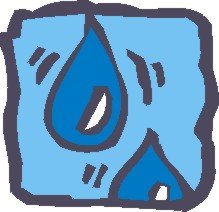Hypothermia
Hypothermia, or cooling of the body's temperature, can happen any time of the year with fatal results. Most cases occur when temperatures are between 30 and 50 degrees F. Windy conditions and wet clothes can work together to chill the unaware, even on a summer day. Once chilled, the body begins to "shut down". The brain loses function, leading to poor judgment. Hypothermia victims often can't help themselves so it is important for each group member to be aware of prevention and treatment methods.
 To Prevent Hypothermia
To Prevent Hypothermia
 Dress in layers. The outer layer should be wind and water resistant, and inner layers should be fabrics that are "warm when wet" (wool or synthetics, but not cotton). A hat may be your most important layer in preventing heat loss. Take layers off if you begin to sweat and put them back on when you cool down.
Dress in layers. The outer layer should be wind and water resistant, and inner layers should be fabrics that are "warm when wet" (wool or synthetics, but not cotton). A hat may be your most important layer in preventing heat loss. Take layers off if you begin to sweat and put them back on when you cool down.
 Stay well fueled. Snack on high carbohydrate foods and drink lots of water. Water helps your body turn calories into heat.
Stay well fueled. Snack on high carbohydrate foods and drink lots of water. Water helps your body turn calories into heat.
 Watch for signs of hypothermia. If someone in your party gets cold, take a break to give them more clothes and food. Hypothermia symptoms include: intense shivering, fatigue, stumbling or poor coordination, slurred speech, and irrationality.
Watch for signs of hypothermia. If someone in your party gets cold, take a break to give them more clothes and food. Hypothermia symptoms include: intense shivering, fatigue, stumbling or poor coordination, slurred speech, and irrationality.
To Treat Hypothermia
Shelter the victim from the wind and weather. Remove any wet clothing and place victim in dry clothes or a sleeping bag. If necessary, put another warm person in the sleeping bag with them. If the victim is alert, give them warm liquids and food. In the case of advanced hypothermia, handle very gently and get medical help immediately. Rough handling can cause a heart attack.
Also see cold water immersion

